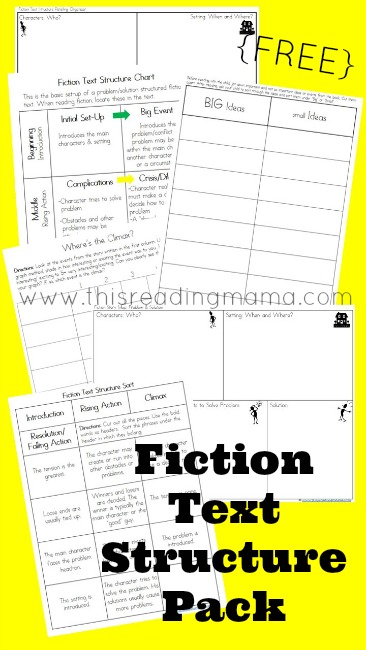
Welcome back to 5 days of Teaching Text Structure to Readers, a part of iHomeschool Network’s January Hopscotch! If you missed day one, which had an introduction to text structure and a few text structure giveaways, be sure to click on the image above or HERE!
*Please note that this post contains affiliate links. To read more about this, visit my full disclosure policy.
By far, fiction is typically the most familiar kind of texts to kids. Why? Because starting out young, we start telling them oral stories. We read stories to them in our laps or cuddled up under a blanket. Kids like a good story. At least mine sure do. “Tell it again, mama!” But some readers still struggle with fiction text structure. They struggle to understand what is important to the story and what isn’t so important. Some of the young readers I tutored would retell the story line including every.single.detail. Asking them to retell the story in 2-3 sentences was a struggle.
Fiction Text Structure (The Structure of a Story)
Fiction text structure (as known as the plot) is pretty straight forward and typically goes something like this:
1. Beginning–> Introduction of the characters, setting and the main problem
2. Middle–> There is a rise in action as the main character tries to solve the problem, more problems and obstacles may be introduced as well. The climax takes place as the character faces the problem head-on and makes his decision.
3. End–> There is a fall in action, as the problem is solved. “Good guys” usually win and bad guys don’t.
It is important for readers to be able to recognize and locate these text features, as they are vitally important to the story line. They are the important parts.
Pitfalls of Retelling Narrative Stories
I love how Emily Kissner, in her book Summarizing, Paraphrasing, and Retelling (pg. 84), shares several pitfalls that await kids with narrative text, especially as they begin to read more complex texts. She suggests talking about these with kids so that these don’t trip them up.
- Heavy Dialogue: Text that is very heavy in dialogue is often hard to paraphrase or retell because the story line is hidden in the conversation
- Flashbacks or Flashforwards: Texts that contain “flashbacks (events that occur before the main setting of the story) and flashforwards (events that occur after the main problem)” often interrupt the flow of the story line.
- The Conflict Isn’t as Clear: Sometimes stories contain one main problem, but many smaller complications and obstacles, which can prevent readers for locating the main problem of the story. She also shares that sometimes the main conflict is internal (inside the mind of a character) and hard to find.
- 1st Person: Narratives told in first person tend to have a lot of dialogue and many things have to be inferred (or figured out) from the dialogue alone. The person’s name, for example, may only be found in the dialogue.
More Resources for Fiction Text Structure
- Fiction Story Elements and Text Structure
- Many movies or cartoon shows will have a clearly defined problem and solution for kids to see.
- Fairy Tales also make great problem/solution texts. You can download my Fairy Tale pack, which helps kids see this text structure.
- Teaching Fiction Text Structure (Helping kids learn to retell)
- Teaching Readers How to Summarize Fiction
- Follow my Comprehension Pinterest Board, where I pin activities and ideas for text structure and teaching comprehension.
FREE Fiction Text Structure Printable Pack
I have created a bundled pack of several activities/organizers you can use with your reader when working on fiction text structure. Click HERE or on the image above to download. You will find each printable twice (one that would appeal more to younger kids and one for older kids). I’ve also included a couple of activities for those fiction stories that don’t follow the problem/solution structure.
~Becky

You have so many great printables! It’s interesting to see that retelling is sometimes even difficult for adults when you hear two different people summarizing the same movie or book 🙂
Thank you, Natalie! I agree that some adults also struggle with summarizing as well. 🙂